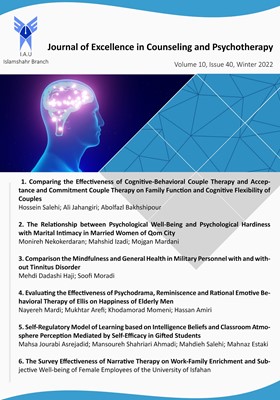-
-
List of Articles
-
Open Access Article
1 - Comparing the Effectiveness of Cognitive-Behavioral Couple Therapy and Acceptance and Commitment Couple Therapy on Family Function and Cognitive Flexibility of Couples
Hossein Salehi Ali Jahangiri Abolfazl Bakhshipour -
Open Access Article
2 - The Relationship between Psychological Well-Being and Psychological Hardiness with Marital Intimacy in Married Women of Qom City
Monireh Nekokerdaran Mahshid Izadi Mojgan Mardani -
Open Access Article
3 - Comparison the Mindfulness and General Health in Military Personnel with and without Tinnitus Disorder
Mehdi Dadashi Haji Soofi Moradi -
Open Access Article
4 - Evaluating the Effectiveness of Psychodrama, Reminiscence and Rational Emotive Behavioral Therapy of Ellis on Happiness of Elderly Men
Nayereh Mardi Mukhtar Arefi Khodamorad Momeni Hassan Amiri -
Open Access Article
5 - Self-Regulatory Model of Learning based on Intelligence Beliefs and Classroom Atmosphere Perception Mediated by Self-Efficacy in Gifted Students
Mahsa Jourabi Asrejadid Mansoureh Shahriari Ahmadi Mahdieh Salehi Mahnaz Estaki -
Open Access Article
6 - The Survey Effectiveness of Narrative Therapy on Work-Family Enrichment and Subjective Well-being of Female Employees of the University of Isfahan
Marziyeh Malekiha -
Open Access Article
7 - The Relationship between Personality Characteristics and Life Satisfaction with the Mediating Role of Emotional Intelligence
Mohammad Reza Mazloomzadeh Bahram Ali Ghanbari Hashemabadi Atefeh Jahangiri
-
The rights to this website are owned by the Raimag Press Management System.
Copyright © 2021-2025







